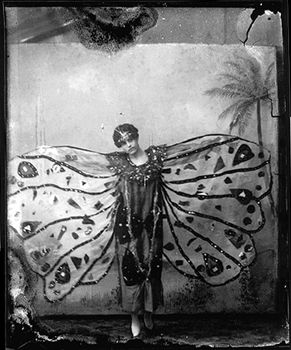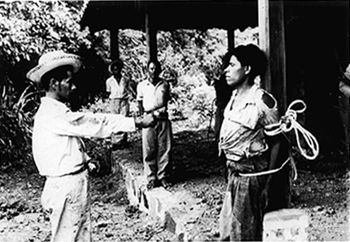 |
| February
2000 |
a
travelling exhibition
Americas Society
680 Park Avenue (at 68th Street) 212-249-8950
Until April 16, 2000 Tues-Sun., 10:00 am-6:00 pm
www.americas-society.org

José Domingo Noriega. "Ladina disfrazada de mariposa." s.f.
"Ladino woman in butterfly costume." n.d.
|
|
In
the last twenty years the field of History of Photography has
been changing and expanding rapidly: in the 1950s historians
who were themselves European or North American usually ignored
the rest of the world and included only Western Europe and North
America as the major players in that field.
But gradually, as other fields emerge, our knowledge becomes
much more complex and sophisticated: Mexico, Africa and the
Middle East and Eastern Europe among others have been the subject
of recent exhibitions in New York. Picturing Guatemala, the
first survey of Guatemalan photography ever to be presented
here, is an important addition to the photographic field and
brings in fresh, beautiful and impressive material, never seen
in the US before. In the last two years the exhibit has circulated
al through Central America. It is also on view at the Museo
Latino in Los Angeles and will go on to Brazil and Spain later
this year.
In over 100 images from the CIRMA Archive, one of the most important
funds in all of Central America and one that maintains an independent
political perspective, the exhibition, curated by Valia Garzon
Diaz, explores the development of photography in Guatemala and
offers us a view of the nation's cultural history.
The 19th century portion opens with rows of carte de visite
portraits. Some of them represent middle and upper-class families.
Others that feature artisans, sailors, peasants and indigenous
people have often been shot by foreign anthropologists and used
for the contruction of typlogies based on race. However as we
see them in this show's context we can freely focus on the variations
of costumes, from the simple indigenous dress to the Europeanized
costumes of the middle-class and individual expressions, thoughful,
shy, proud , inquisitive and even ironic in certain cases.
Portraits
in natural environments are at first rare. The pictures
are often shot in European-style studios with painted
backgrounds which make for surreal contrast (see for instance
the 1940 picture by Zanotti of two men from Quetzaltenango
leaning on a ornate bronze rococo pedestal) the personality
of the subjects shines through. Especially striking is,
for instance, a portrait by Valdeavellano of a Maya Woman
from Mixco,dating back to 1895, which evokes Mexican portraits
by Graciela Iturbide, while an anonymous shot of Maya-Lacandon
women makes us think of Gertrude Blom's portraits. Rare
large format landscapes and urban views from photographic
albums by Muybridge, who went to Guatemala in 1875, are
also prominently displayed together with an album depicting
the Guatemalan pavilion at the Exposition Universelle
in Paris in 1889.
|

"Campesinos arbenzistas capturados depués
del derrocamiento de Arbenz" 1954
"Arbenzista peasants captured after overthrow of Arbenz"
1954
Original - Familia/Family
E. Taracena de la Cerda |
While early twentieth century photographers such as Yas, Noriega
and Zanotti still use the posed portraits, as of the 1920s the
Guatemalan and foreign photojournalists become more attuned
to international style: action shots, such as the ones taken
in the 1917 earthquake in Guatemala City are more common. But
even in the 20th century some photographers carry on the tradition
of the large-format, as in funerary portrait where the groupings
and poses often evoke black photographer Van der Zee.
The exhibition also features a wealth of contemporary photographers
such as Daniel Cauche, Marria Cristina Orive, Roberto Eichenberger,
Mitchell Denburg, Sol Liebsohn, Patricia Goudvis. Together with
some colleagues that remain anonymous, they have covered everyday
life, religious rituals and political events in Guatemala's
chaotic history. All of the work is in black and white. Some
photographers have been working in a photojournalistic style
but others have interestingly combined the interest in their
country' present with the tradition of anthropological portrait.
MORE PICTURES
FROM CENTRAL AMERICA:
For twenty-five years, photographer and editor Maria Cristina
Orive , whose work is featured in Picturing Guatemala has been
running La Azotea Editorial Fotografica, an independent publishing
house that features the best in Guatemalan and Central American
photography.
Among the most recent titles, some of them re-publications of
out-of-print titles are:
- Pablo Neruda by Sara Facio: an intimate and
tender portrait of the great Chilean poet where a series of
150 photographs are associated with quotes fom him or from his
works.
-
Foto de Escritor by Sara Facio. A friend of many
writers since the 1960s, Facio assembled in-depth portraits
of artists such as Asturias, Borges, Silvina Ocampo, Alejo Carpenter
and many others. Also a writer, Facio often added her comments
or quotes from the writers next to their pictures.
- Luis Gonzales Palma: Palma is probably the only
Guatemalan photographer to date who has been exhibiting regularly
in New York for the last eleven years. His large-format installations
are deeply rooted in the religious mythology of his country.
- Fotografia Argentina Actual (two volumes) is
an overview of twenty young Argentinian photographers working
in their country or abroad.
-
Foto de Escritor by Sara Facio is on sale at Amazon.com
All other books can be obtained directly from La Azotea through
their website: www.laazotea.com.ar
or from their distributor in California, photoeye.com. Once
ordered the books will be dispatched by airmail from Buenos
Aires. The price of postage is already included in the quote
obtainable from La Azotea.
|

|
|



